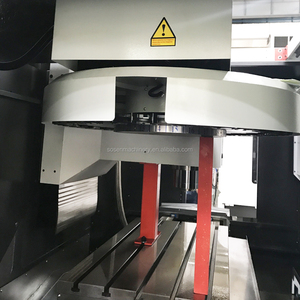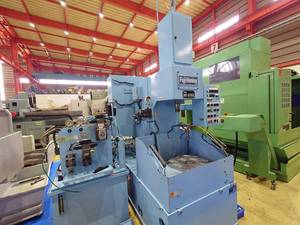
All categories
Featured selections
Trade Assurance
Buyer Central
Help Center
Get the app
Become a supplier

(42277 products available)


























A heavy-duty CNC milling machine is more powerful and bigger than regular CNC milling machines. It can process larger workpieces and tougher materials. Because of its size and mass, a heavy-duty CNC milling machine shakes less, so it can work more accurately. The following are three typical types of heavy-duty CNC milling machines.
Heavy-duty CNC gantry milling machine
A heavy-duty CNC gantry milling machine has a milling machine supported by two vertical components (called parallel legs) on a cross beam. A CNC gantry machine comes in a few different configurations. They include open or half-open structures, the latter of which has only one side of an open channel, and single or double rails. Gantry machines are suitable for cutting large and heavy workpieces with great accuracy.
Heavy-duty CNC vertical milling machine
An ordinary vertical milling machine has a heavy-duty spindle, table, and column. In a CNC vertical milling machine, the computer controls the workpiece and the tool's movements. A vertical milling machine means that the column and spindle holding the tool are perpendicular to the horizontal table that holds the workpiece.
With a more powerful spindle and a bigger table, a heavy-duty vertical milling machine can handle bigger workpieces and heavier cutting. These machines usually have dro and power feed on the axes.
A vertical CNC milling machine may use a VFD or servo system to control its speed. In the case of a heavy-duty machine, a gearbox is more common because it needs to generate more torque. Heavy-duty vertical machines may also mount Direct Drive spindles that connect directly to the motor without a gearbox.
Heavy-duty CNC horizontal milling machine
A horizontal heavy-duty CNC milling machine is like an ordinary horizontal milling machine, except that a computer controls it. The column and spindle in a horizontal milling machine are parallel to the legs and feet supporting the work table. Like its vertical counterpart, a heavy-duty horizontal CNC milling machine may come with more advanced accessories, such as dro and power feed on the axes.
Heavy-duty CNC horizontal milling machines are good for making flat surfaces parallel to the bottom of workpieces and for making deep cavities and grooves in thicker materials.
Heavy duty CNC mill machines are designed with remarkable specifications to achieve optimal results and handle demanding tasks. Some key specifications include:
Spindle Power
The spindle power of heavy duty CNC milling machines is higher than that of standard machines. Spindle power can range between 10 kW and 25 kW. The higher spindle power offers greater cutting capabilities, such as machining thick workpieces and using large-diameter cutters. It also ensures that the machine will deliver consistent performance under demanding tasks.
Spindle Speed
The spindle speed of heavy duty CNC milling machines tends to be lower. While standard CNC milling machines can achieve spindle speeds of up to 30,000 rpm, the spindle speed of heavy duty machines is typically between 3,000 rpm and 10,000 rpm. Heavy duty machines prioritize torque over high speed to allow the cutter to efficiently penetrate and shape dense materials.
Feed Rate
The maximum linear heavy duty milling machine CNC feed rates are higher than those of standard milling machines. Where standard machines achieve a maximum linear feed rate of 20,000 mm/min to 30,000 mm/min, heavy duty machines can achieve maximum linear feed rates of 30,000 mm/min to 50,000 mm/min or even higher. The higher feed rates help to reduce machining time and increase production efficiency.
Tool Capacity
Heavy duty CNC milling machines usually have higher tool capacities than standard milling machines. Machines with a low tool change time and high tool capacities can minimize production costs and maximize efficiency. Depending on the model, heavy duty CNC milling machines can have tool capacities ranging from 30 to more than 100. The most common types of tool changers are chain, disk, and drum changers.
Machining Area
CNC heavy duty milling machine centers with larger machining areas allow more extensive workpieces to be processed and even allow the machining of multiple workpieces at once. The machining area dimensions are commonly 1,600 x 3,200 mm.
Machines used in heavy production environments with high demands need to be maintained regularly to ensure their stability and accuracy, which are the two most critical pillars of resistance and precision. Regularly calibrating the guiding and transmission systems to keep the machine functioning correctly is a vital aspect of its maintenance. Some general maintenance tips are as follows:
It is also crucial to create a regular maintenance schedule for the machine so that it can be serviced by a professional at the prescribed intervals.
A wide range of industries use heavy CNC milling machines for different applications. Below are some of the industry applications of heavy-duty CNC milling machines:
Aerospace industry
The aerospace industry makes complex parts with heavy-duty CNC machines. Because the parts need to be precise and usually lightweight, the material could be titanium, alloy, or aluminum. The CNC machine control gives accuracy that works well for the demands of the aerospace industry.
Automotive industry
For making cars and other vehicles, the automotive industry uses heavy-duty CNC milling machines for the precision cutting and shaping of metal parts. The heavy-duty machines shape parts from solid metal pieces and cut parts like cylinder heads, engine blocks, wheel hubs, valve bodies, and pump housings. It can make complex vehicle parts quickly and precisely. That is why it's perfect for heavy-duty CNC machines with automatic tool changers. These changers let the machine switch tools by itself during work. This saves time and helps production go faster.
Construction industry
In the construction industry, CNC machines heavily shape metal and other materials for building projects and infrastructure. The machines cut and shape materials like steel, aluminum, wood, glass, plastic, stone, and composites. They are used to construct the Building heavy structures like bridges, frames, and facades. The machines create detailed architectural elements and prototypes. With its automation process, the production speed meets the large scale of construction projects.
Mold and die industry
Die and mold industries rely on heavy-duty CNC machines to make precision molds and dies used for manufacturing plastic parts, metal components, and casting products. The heavy-duty CNC machine creates molds and dies quickly and accurately. The mold and dies can be for injection molding, blow molding, extrusion molding, stamping, or casting. With its automation, the CNC milling machine smoothly operates and produces products. It meets the high demand and large volume requirements of the die and mold industry.
Marine industry
Heavy-duty CNC milling machines in the marine industry make parts for ships, boats, and submarines. The material is normally steel or aluminum. The machines shape complex components like hulls, propellers, shafts, brackets, and deck fittings, etc. Job workers need strong, durable tools. They also need tools that can cope with heavy use. That is why they prefer CNC milling machines with a heavy duty design.
Medical and healthcare
Medical and healthcare use CNC machines for milling to create surgical instruments, implants, prosthetics, and medical devices. The materials include titanium alloy, stainless steel, and engineering plastics. The heavy-duty CNC machines make precise, reliable devices and instruments for the medical field.
Consider the following factors when choosing a heavy duty CNC milling machine:
Q1. How does a CNC milling machine work?
A1. CNC milling machines cut and shape materials into various profiles and designs. Initially, the material is secured onto the CNC cutting surface using clamps or vises. The design is then uploaded into the machine’s software, and the machine is set to work. An axis with a cutter moves towards the material and begins to cut according to the design. This process repeats until the cutter carves out the design.
Q2. What is the maximum cutting thickness of a heavy-duty CNC milling machine?
A2. The maximum cutting thickness for heavy-duty CNC milling machines usually ranges from 800mm to 1000mm. However, this varies depending on the machine model and specifications. Always check the manufacturer specs to find out the maximum cutting thickness.
Q3. Can a heavy duty CNC milling machine be moved?
A3. Yes, generally, heavy-duty CNC milling machines can be moved. Many machines have optional parts that can be disassembled and transported in a single camion. With proper handling, these machines can be moved to new settings safely. However, moving a machine is a complex task. Always seek professional help when moving an industrial CNC machine.
Q4. Does a heavy-duty CNC milling machine have accessories?
A4. Yes, heavy-duty CNC milling machines have many accessories. Some of the accessories include tool holders, vises, clamps, deburring wheels, tapping heads, and rotary tables.
Q5. How does one maintain a CNC milling machine?
A5. CNC milling machines need maintenance for longevity and reliable service. Manufacturers recommend regular cleaning to remove debris and dust. Also, routinely check and replace worn out parts like belts and bearings. Users should also apply lubricants to the guide rails and axes and calibrate the machine periodically to maintain cutting precision.